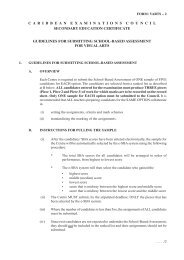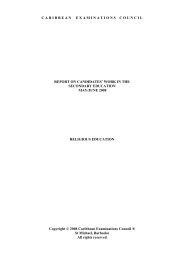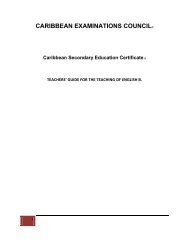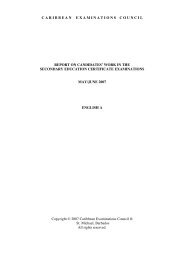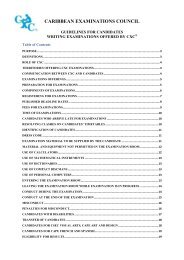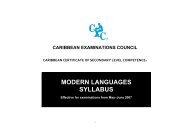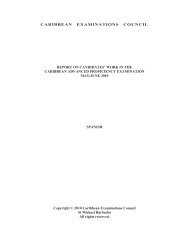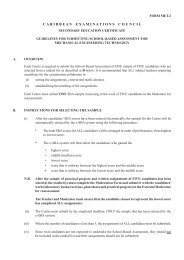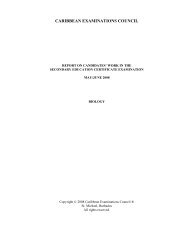The Caribbean Examiner ⢠Vol 9 ⢠No 1 ⢠May 2011
The Caribbean Examiner ⢠Vol 9 ⢠No 1 ⢠May 2011
The Caribbean Examiner ⢠Vol 9 ⢠No 1 ⢠May 2011
Create successful ePaper yourself
Turn your PDF publications into a flip-book with our unique Google optimized e-Paper software.
<strong>The</strong> <strong>Caribbean</strong> <strong>Examiner</strong><br />
CVQ Issues and Challenges<br />
<strong>The</strong> fifth condition to be met according<br />
to Boston (2005) is for the governments to<br />
provide some incentives to the industrial sector<br />
so that their participation in the delivery of the<br />
programme within secondary schools has a<br />
tremendous benefit to them; as the education<br />
sector will be providing industry with outputs<br />
that do not need to be trained from scratch but<br />
come with a head start. Regional governments<br />
must sell to the industrial sector that the delivery<br />
of TVET education in secondary schools is not<br />
just in the interest of educational, but also the<br />
industry. This must therefore be approached as<br />
a partnership both in terms of investment and<br />
participation.<br />
<strong>The</strong> sixth condition to be met lies in the<br />
understanding of the respective roles and<br />
responsibilities of the three agencies involved<br />
in the implementation and delivery of the CVQ<br />
programme in the region as outlined earlier in<br />
this article. Some countries do not have a fully<br />
developed NTA. In some of these countries there<br />
are attempts by the ministry of education to try to<br />
perform some of the functions of the NTA. <strong>The</strong><br />
CVQ is an evidenced-based qualification and<br />
does not depend on an external examination. <strong>The</strong><br />
quality assurance procedures being used by CXC<br />
will ensure that those separation of functions<br />
are followed. <strong>The</strong> development of the standards,<br />
training and certifying of assessors, internal<br />
and external verifiers, conducting the facility<br />
audits and the certifying of centres to deliver the<br />
programme are the role and function of the NTA<br />
and not the ministry of education. It is important<br />
to the validity of the CVQ that these functions<br />
remain separate. If a country does not have an<br />
NTA then it can acquire the services of an NTA<br />
from another country to fulfill those functions.<br />
One of the challenges is that this option is proving<br />
to be costly but the validity of the qualification<br />
is paramount.<br />
<strong>The</strong> final condition to be met in this region<br />
lies in the resourcing of the schools. Across<br />
the region there are countries at various levels<br />
of development. Some countries have schools<br />
with materials and equipment, even though not<br />
modern equipment, while others have a scarce<br />
materials and equipment in schools to support<br />
the programme. This disparity lies not only<br />
among different countries but among different<br />
schools within the same country. It was observed<br />
that in many cases teachers bought materials out<br />
of their own pockets or the students brought<br />
their own materials so as to enable programme<br />
delivery. As the programme expands, some<br />
countries and schools are eager to offer the<br />
programme because they think it is more suitable<br />
for their students but the equipment is in many<br />
cases outdated or scarce. Offering a programme<br />
with such equipment undermines the condition<br />
already met by the CVQ which was that it was<br />
developed using industry standards. Thus, this<br />
can affect the validity of the qualification if<br />
the quality assurance procedures and facility<br />
standards are not sound. Another resource<br />
observed in the CVQ implementation is that<br />
teachers need support in the implementation of<br />
the programme especially during the first cycle<br />
of implementation. It was observed that many<br />
teachers needed support in filling the various<br />
evidence-gathering forms and understanding the<br />
depth and breadth to teach, with respect to the<br />
range of statements where there was an absence<br />
of curriculum materials. It must be noted that in<br />
most countries there is the absence of curriculum<br />
materials for the CVQ. It was also observed that<br />
many ministries of education have only a few<br />
Education or Curriculum Officers specializing<br />
in TVET. <strong>The</strong>se were not enough to provide<br />
support for the teachers. In one country this<br />
problem was solved by the NTA officers who<br />
provided that support to the teachers. Ministries<br />
of education are responsible for the delivery of<br />
the CVQ programme and must ensure that the<br />
schools are adequately resourced and that the<br />
teachers are given support in the first cycle of<br />
implementation of CVQ qualification.<br />
Conclusion<br />
<strong>The</strong>re needs to be much effort in six of the<br />
seven conditions identified and discussed in this<br />
article. Boston (2005) remarked that ‘...drawing<br />
vocational qualifications into secondary schools<br />
is a huge challenge” (p. 4). <strong>The</strong> region has a long<br />
way to go in the implementation of the CVQ both<br />
in and out of schools. <strong>The</strong> implementation of the<br />
CVQ in schools depends on the strengthening<br />
of TVET outside of schools. All the agencies<br />
involved in TVET across the region must work<br />
together in creating that alternative path for the<br />
school population so that students having the<br />
CVQ can according to Morgan (1994) “have<br />
a qualification that is respected and valued by<br />
employers and, more importantly, the students<br />
themselves” (p. viii).<br />
BIBLIOGRAPHY<br />
Boston, K. (2005). How to Draw Vocational<br />
Qualifications Into Secondary Education.<br />
TECHVOC, <strong>Vol</strong> 6, <strong>No</strong>. 1, p 1 – 3 & 11.<br />
Morgan, D. Forward. <strong>The</strong> NVQ Assessor and<br />
Verifier Handbook, Third Edition. By Jenny<br />
Tucker and Ros Ollin. London: Kogan Page<br />
Limited, 1994. Vii-viii.<br />
Skilbeck, M., Connell, H., Lowe, N., Tait, K.<br />
(1994). <strong>The</strong> Vocational Quest. New Directions in<br />
Education and Training. London: Routledge.<br />
Henderson Eastmond<br />
is a Measurement and<br />
Evaluation Officer with<br />
the <strong>Caribbean</strong> Examinations<br />
Council (CXC)<br />
and has responsibility<br />
for the assessment aspect<br />
of the CVQ.<br />
www.cxc.org MAY <strong>2011</strong> 25




